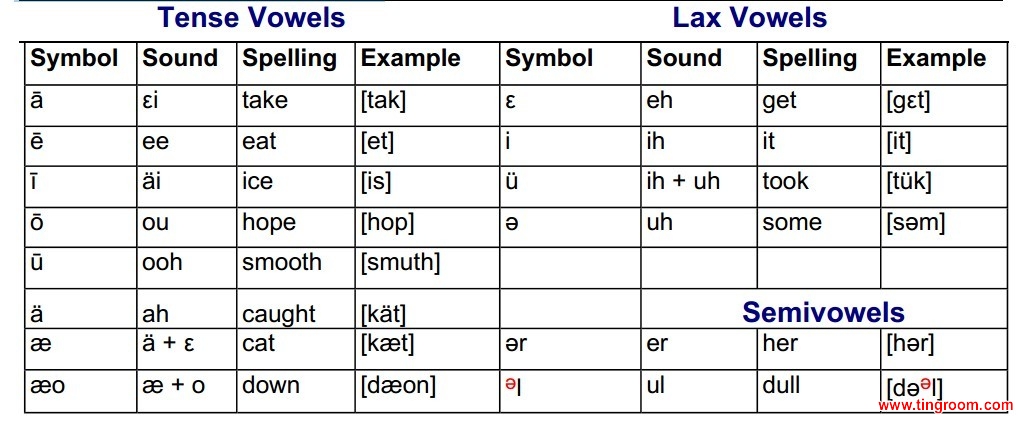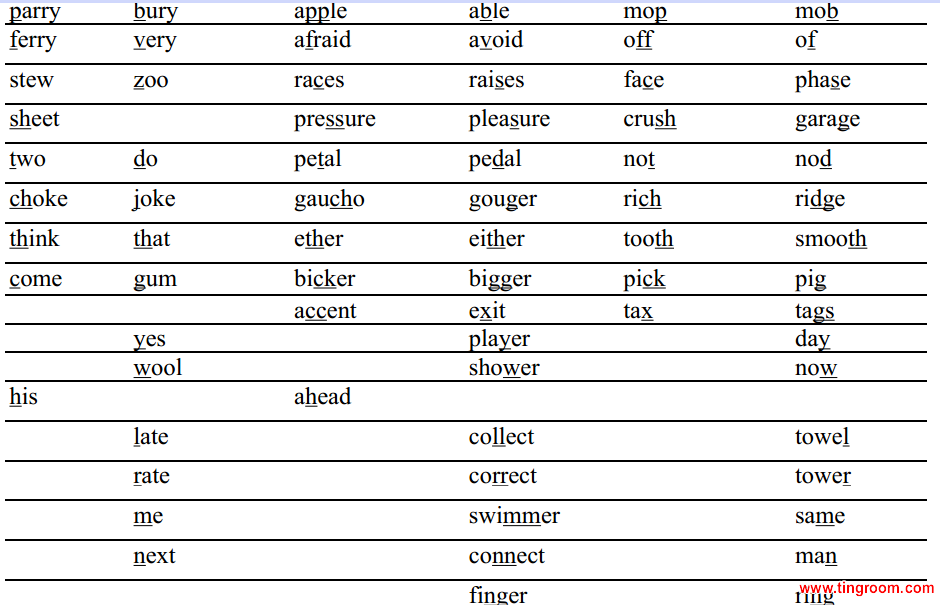标准美语发音的13个秘诀 CD 1 Track 2(在线收听)
A Few Words On Pronunciation CD 1 Track 2
I'd like to introduce you to the pr onunciation guide outlines in th e following chart. There aren't too many characters that are di fferent from the standard alpha bet, but just so you'll be familiar with them, look at the chart. It shows eight tense vowels and six lax vowels and semivowels.
Tense Vowels? Lax Vowels?
In some books, tense vowels are called long and lax vowels are called short. Since you will be learning how to lengthen vowels when they come befo re a voiced consonant, it would be confusing to say that hen has a long, short vowel. It is more descriptive to say that it has a lax vowel that is doubled or lengthened.

图片1
Although this may look like a lot of characters to learn, there ar e really only four new ones: æ, ä, ə , and ü. Under Tense Vowels, you'll notice that the vowels that say their own name simply have a line over them: [ ā], [ ē ], [ ī], [ ō], [ ū] . There are three other tense vowels. First, [ä], is pronounced like the sound you make when the doc tor wants to see your throat, or when you loosen a tight belt and s it down in a soft chair— aaaaaaaah ! Next, you'll find [æ], a combination of the tense vowel [ä] and the lax vowel [ ε ]. It is similar to the noise that a goat or a lamb makes.The last one is [æ o], a combination of [ æ] and [o]. This is a very common sound, usually written as ow or ou in words like down or round.
A tense vowel requires you to use a lot of facial muscles to produce it. If you say [ē ], you must stretch your lips back; for [ ū ] you must round your lips forward; for [ä] you drop your jaw down; for [ æ] you will drop your jaw far down and back; for [ ā ] bring your lips back and drop your jaw a bit; for [ī] drop your jaw for the ah part of the sound and pull it back up for the ee part; and for [ō ] round the lips, drop the ja w and pull back up into [ū ]. An American [ ō ] is really [ ōū].
V Now you try it. Repeat after me. [ē ], [ū], [ā ], [æ ], [ä], [ī ], [ō].
vii
A lax vowel, on the other hand, is very reduced. In fact, you don't need to move your face at all.You only need to move the back of your tongue and y our throat. These sounds are very different from most other languages.
Under Lax Vowels, there are four reduced vowel sounds, starting with the Greek letter epsilon [ε ], pronounced eh; [i] pronounced ih, and [ü] pronounced ü, which is a combination of ih and uh, and the schwa, [ ə], pronounced uh—the softest, most reduced, most relaxed sound that wecan produce. It is also the most common sound in English. The semivowels are the American R (pronounced er, which is the schwa plus R) and the American L (which is the schwa plus L). Vowels will be covered in greater detail in Chapters 3, 8, and 11.
Voiced Consonants? Unvoiced Consonants?
A consonant is a sound that causes two points of your mouth to come into contact, in three locations—the lips, the tip of the tongue, and the throat. A consonant can either be unvoiced (whispered) or voiced (spoken), and it can appear at the beginning, midd le, or end of a word. You'll notice that for some categories, a particular sound doesn't exist in English.


图片2
Pronunciation Points
1. In many dictionaries, you may find a character that looks like an upside down V, [A] and another character that is an upside-down e [ ə], the schwa . There is a linguistic distinction between the two, but they are pronounced exactly the same. Since you can't hear the difference between these two sounds, we'll just be using the upside-down e to indicate th e schwa sound. It is pronounced uh.
2. The second point is that we do not differentiate between [ä] and [ ] ]. The [ä] is pronounced ah. The backwards C []] is more or less pronounced aw. This aw sound has a "back East" sound to it, and as it's not common to the entir e United States, it won't be included here.
3. R can be considered a semivowel. One characteristic of a vowel is that nothin g in the mouth touches anything else. R definitely falls into th at category. So in the exercises throughout the book it will be treated not so much as a consonant, but as a vowel.
4. The ow sound is usually indicated by [äu], which would be ah + ooh. This may have been accurate at some point in some locations, but th e sound is now generally [æo]. Town is [tæon], how is [hæo], loud is [læod], and so on.
5. Besides voiced and unvoiced, there are two words that come up in pronunciation. These are sibilant and plosive. When you say the [s] sound, you can feel the air sliding out over the tip of your tongue—this is a sibilant. When yo u say the [p] sound, you can feel the air popping out from between your lips—this is a plosive. Be aware that there are two sound s that are sometimes mistakenly taught as sibilants, but are actually plosives: [th] and [v].
6. For particular points of pronunciation that pert ain to your own language, refer to the Nationality Guides on page 172.

图片1